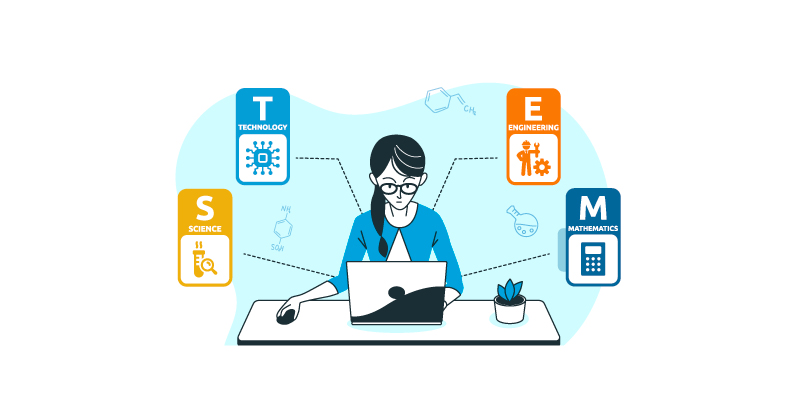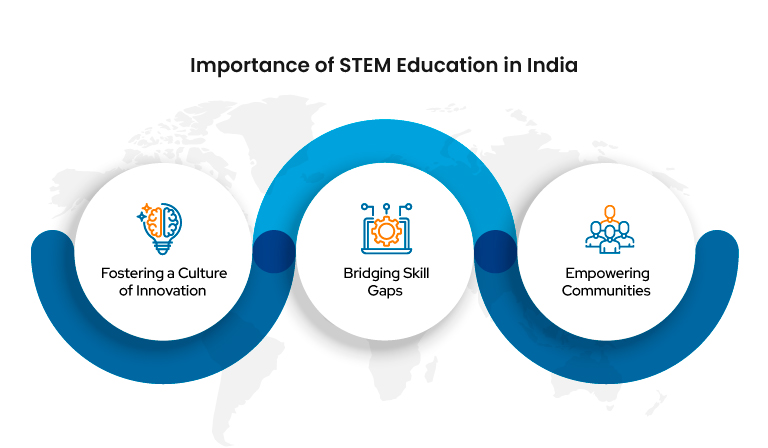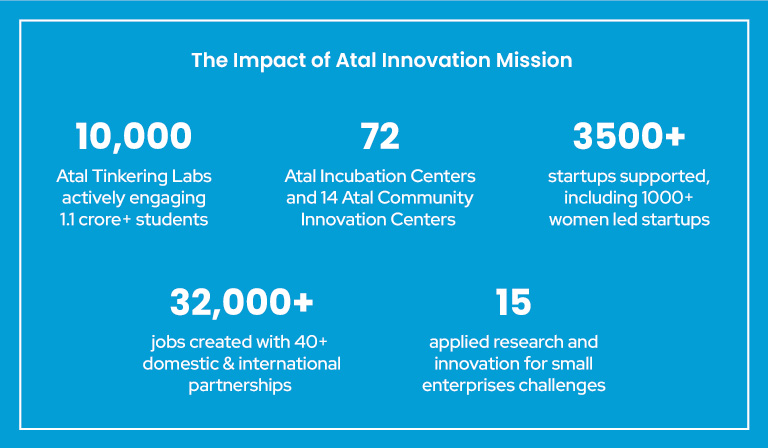Cultivating Innovation: Significance of Technology in STEM Education

The 21st century roars with technological advancements, demanding a skilled workforce equipped to handle complex challenges. In this globalized landscape, STEM education – encompassing Science, Technology, Engineering, and Mathematics – emerges as the cornerstone of national progress. From powering economic growth to tackling environmental issues, technology in STEM education becomes the driving force of a nation’s success.
But what makes STEM so crucial for India, how do we handle STEM education challenges, and how can we effectively cultivate young minds into the innovators of tomorrow?
The Indispensable Role of STEM in Building a Vibrant India

1. Fostering a Culture of Innovation:
Imagine a young student, captivated by the intricacies of robotics, meticulously constructing a solar-powered rover. This is the essence of STEM – igniting curiosity, nurturing problem-solving skills, and encouraging critical thinking. By exposing students to STEM subjects early on, we foster a generation of innovators and entrepreneurs who can tackle real-world challenges with novel solutions. This fuels economic growth and positions India as a global leader in technology and sustainability.
2. Bridging the Skills Gap:
The demand for skilled STEM professionals continues to soar, while the supply struggles to keep pace. Implementing robust STEM education initiatives equips students with the technical knowledge and practical skills crucial for securing in-demand jobs in fields like artificial intelligence, renewable energy, and biotechnology. This not only empowers individuals but also addresses the national skills gap, propelling India’s economic advancement.
3. Empowering Individuals, Transforming Communities:
STEM education goes beyond technical expertise. It cultivates 21st-century skills like critical thinking, problem-solving, and collaboration – abilities indispensable for navigating the complexities of our modern world. These skills empower individuals to become active participants in their communities, enabling them to drive positive change and solve local challenges.
Unveiling the Roadmap: Initiatives Shaping STEM Education in India
Recognizing the immense potential of STEM education, India has launched several promising initiatives:
1. National Education Policy (NEP) 2020:
This transformative policy advocates for holistic learning, breaking down rigid subject silos and encouraging the integration of STEM subjects:
- Flexible Course Options: NEP allows students to choose interdisciplinary electives, allowing them to explore their interests and develop a well-rounded skillset.
- Emphasis on Experiential Learning: The policy promotes project-based learning and inquiry-based approaches, making STEM education more engaging and relevant to real-world scenarios.
- Teacher Training & Support: NEP focuses on upskilling teachers with effective pedagogical techniques for integrating technology in STEM education.

2. Atal Innovation Mission (AIM):
AIM empowers schools and institutions to establish Atal Tinkering Labs (ATLs), vibrant spaces equipped with advanced tools and resources, fostering students’ creativity and innovation:
- Tinkering and Experimentation: ATLs provide students with access to 3D printers, robotics kits, and other tools to experiment, innovate, and build prototypes.
- Mentorship and Collaboration: The program connects students with mentors from industry and academia, fostering knowledge sharing and career guidance.
- National Competitions and Exhibitions: AIM organizes national competitions and exhibitions showcasing student innovations, providing a platform for recognition and inspiration.
- AIM Impact: AIM initiative has successfully established 10,000 tinkering labs, 72 incubation centers and supported over 3500 startups.
3. Skill India Mission:
Launched in 2015, the Skill India Initiative aims to empower the youth of India with market-relevant skills to bridge the skill gap and enhance employability.
- Offers diverse training programs: Short-term vocational courses, apprenticeship opportunities, and degree programs.
- Leverages partnerships: Collaborates with industries, training providers, and government bodies.
- Provides financial assistance: Through scholarships and subsidies for underprivileged students.
- Encourages integration of STEM skills: Many programs focus on technical skills relevant to STEM fields.
- Promotes industry-focused learning: Training curricula align with current industry needs and demands.
- Supports digital literacy: Initiatives like Digital Saksharta Mission bridge the digital divide, integrate technology in STEM education, and equip individuals with essential digital skills.
4. Beyond Policy and Platforms:
- Industry Mentorship Programs: Collaboration between educational institutions and industry leaders can provide students with valuable mentorship, internships, and real-world project opportunities. This connects classroom learning to industry needs and inspires students to pursue STEM careers.
- Community Outreach Programs: Engaging with local communities through STEM workshops, science fairs, and community-based projects can ignite interest in STEM among underprivileged groups and promote broader accessibility to STEM education.
- Investing in Research and Development: Increased funding for research and development in STEM fields will attract talent, foster innovation, and position India as a leader in technology advancements.
5. Technology Integration:
Initiatives like DIKSHA, the national e-learning platform, and cutting-edge high-education platforms like Möbius offer interactive, personalized learning in STEM subjects, promoting accessibility and engagement:
- Digital Content and Resources: These platforms offer a wealth of curated learning materials, including simulations, interactive modules, and gamified experiences, making STEM more accessible and engaging for students in remote areas.
- Adaptive Learning Technology: Möbius STEM learning utilizes adaptive learning algorithms to personalize the learning journey for each student, catering to their individual needs and learning styles.
- Collaborative Learning Tools: These platforms offer tools for online collaboration and project work, fostering teamwork and communication skills among students.
How Möbius Stem Learning Platform Reimagines the Future
Möbius, an innovative e-learning platform tailored for STEM education, offers a unique blend of features:
- Personalized Learning: Möbius offers seamless and continuous connectivity with educators to provide each student with a journey of personalized learning in STEM, catering to their individual needs and learning styles. This maximizes engagement and understanding.
- Engaging Content: Immersive simulations, interactive modules, and gamified experiences make learning exciting and enjoyable. Möbius STEM learning fosters active participation and knowledge retention.
- Online Assessment: The platform features multifaceted student assessment in STEM education that provide real-time feedback, enabling students to monitor their progress and identify areas for improvement. This promotes self-directed learning and goal setting.
- Collaborative Environment: Möbius STEM learning facilitates collaboration and interaction, allowing students to work together on projects, share ideas, and learn from each other. This fosters teamwork and communication skills.
Möbius, alongside other technological advancements, represents a significant step towards reinventing STEM education in India.
Understanding Möbius: A Glimpse into the Future
Imagine a student, captivated by the intricate dance of electrons, dives into an interactive 3D model of an atom. With the click of a button, she/he manipulates virtual particles, witnessing the fascinating interplay of forces that govern our universe. Gone are the dry formulas; the concepts come alive, sparking a deep understanding that textbooks could never achieve.
Möbius STEM learning transcends geographical boundaries by providing high-quality, interactive STEM learning activities accessible through digital devices. This empowerment breaks down barriers, bridging the digital divide and equipping learners to compete on a global stage.
The future of STEM education with Möbius is powered by innovation. Imagine classrooms transformed into interactive hubs where students become active participants in their learning, driven by curiosity and a thirst for knowledge. Imagine personalized learning pathways, each catering to individual strengths and interests. This is the power of Möbius.
By embracing technology in STEM education along with personalized, and interactive learning, Möbius classroom paves the way for accessible, engaging, and effective STEM education, empowering future generations of innovators and problem-solvers.
Conclusion
Investing in STEM education is not just a choice; it’s a necessity for India’s future. By nurturing young minds with critical thinking, problem-solving, and technological skills, we empower them to become active participants in building a vibrant and innovative nation.
Welcoming platforms like Möbius to integrate technology in STEM education can transform learning into an inclusive and engaging journey. Let us equip our students with the tools they need to not only secure successful careers but also become the architects of a brighter future for India.
As Nelson Mandela eloquently stated, “Education is the most powerful weapon which you can use to change the world.” Let us wield this weapon wisely, cultivating future innovators, one Möbius classroom at a time.
Want to explore the Möbius experience? Book a personalized demo today!